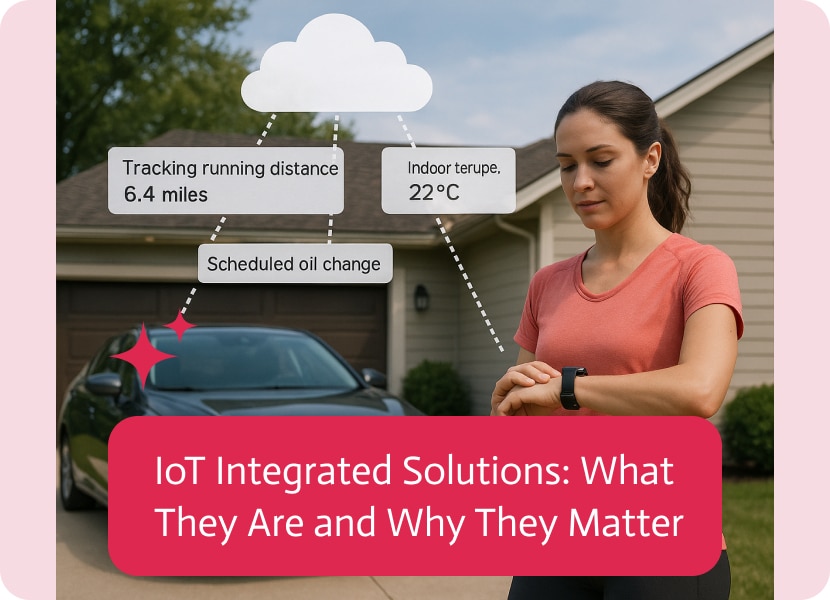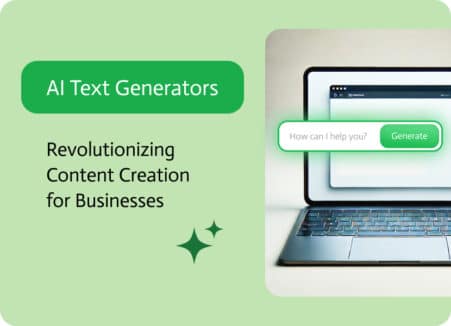

IoT Integrated Solutions: What They Are and Why They Matter
IoT integrated solutions refer to systems where Internet of Things (IoT) devices are connected, managed, and automated together with other technologies (software, platforms, or business systems) to deliver cohesive, intelligent outcomes, not just raw data.
The phrase “Internet of Things” (IoT) gets tossed around a lot these days, but what really moves the needle in business and technology isn’t just having smart devices; it’s connecting them into something greater. That’s where IoT-integrated solutions come in. These are not just flashy gadgets reporting random data; they are part of larger, intelligent ecosystems that work in sync to drive efficiency, automation, and insight.
First, What is The Internet of Things?
The Internet of Things, abbreviated to IoT, is just a bunch of everyday stuff, like machines, cars, thermostats, and even your coffee pot, that are hooked up to the internet. They can send, get, and mess with data. These things have software, sensors, and Wi-Fi, so they can keep an eye on what’s going on around them or how well they’re working and then share that info.
But here’s the catch: the act of collecting only data doesn’t do much unless that data is used wisely. This is where integration shows its true potential
What Are IoT Integrated Solutions?
IoT integrated solutions are systems where IoT devices are linked, not just to the internet but to each other and to platforms, enterprise systems, and cloud applications that make the data useful.
Think of it this way:
- A sensor that measures temperature is helpful.
- A sensor that tells your HVAC system to adjust when temperatures spike, logs this event in a central dashboard, and alerts your facilities manager? That’s an integrated solution.
IoT integration brings multiple moving parts together, hardware, data pipelines, software platforms, automation criteria, and analytics into a single coordinated operation.
Anatomy of an IoT Integrated Solution
An IoT system is like a watchful network that collects and acts on information in real time. The tech becomes less abstract if you compartmentalize it.
1. IoT Devices
They could be referred to as the eyes and ears of the world; all these little gadgets grab facts from everywhere. Here’s a quick overview of some key components:
- Temperature sensors that double-check whether your freezer is really cold.
- GPS trackers guide delivery trucks along the fastest route.
- Motion detectors alert a security team when a door swings open.
- Pressure gauges are watching offshore oil rigs for signs of trouble.
- Smart meters report how your specific neighborhood is eating up electricity.
2. Connectivity Layer
Once the facts are gathered, they have to hop somewhere, and that hop isn’t always fast or free. Options include:
- Wi-Fi or Ethernet for devices that sit in one place.
- Cellular networks if the hardware needs to roam.
- Low-power networks such as LoRaWAN, Zigbee, or NB-IoT that stretch battery life but send short messages.
3. Data Processing & Storage
Raw numbers don’t help much, so they have to be tidied up. Processing can happen:
- At the edge, just a heartbeat from the sensor, so delays are tiny.
- In the cloud, where storage and horsepower scale with demand.
4. Integration Middleware
Think of middleware as a bilingual friend taking notes in two languages at once. It makes sure:
- Device data lands in the right software without getting lost.
- Different protocols speak a common tongue.
- Business rules, like alerting the manager if humidity tops 80 percent, are followed.
5. Applications & Dashboards
This layer is what real people poke at. Graphs, alerts, and buttons surface so users can:
- Track inventory in a warehouse from a coffee shop.
- Spot machinery that might break down next week.
- Watch the live location of service technicians on a map.
Real-World Use Cases
None of this is science fiction. Hospitals map patient vitals to nurses’ phones, farmers track soil moisture to decide when to water, and manufacturers smooth out production lines before glitches cost money.
Manufacturing
Every machine on the shop floor now packs its own set of tiny vibration and heat sensors.
Those pieces of data zip across the plant floor and land on a centralized monitoring platform in seconds. The software automatically fires a maintenance ticket into the company ERP with zero human touch. Thanks to that split-second reaction, unplanned downtime shrinks and efficiency inches up where it really counts.
Smart Buildings
Motion detectors, air quality monitors, and LED drivers chatter constantly when no one is awake in the room. Lights drift down to a whisper, the fan slows, and the kilowatts slide into the green without anyone even noticing. A single online dashboard keeps building managers in the loop, yet almost everything happens without their direct involvement.
Agriculture
Underground probes track soil moisture and nutrient levels like a nervous doctor reading vital signs. The sprinklers click on only when the numbers fall past a preset line, no leaky hoses, no guesswork. That same data slides into yield-prediction software, allowing farmers to plan fertilizer runs without creeping through the field.
Logistics
Diesel rigs now carry GPS breadcrumbs and cabin thermometers that never blink off. A single spike or dip in cargo temperature sets off a shrill alert that rolls to the driver and the dispatcher at once. Customers opening their phones five states away already know the fridge trailer is still on course.
Why Integration Is Critical
IoT looks impressive, but a stream of beeps and blips becomes mere noise without a connective tissue. A sensor can scream that a pump is hot, yet that shriek is useless until someone or something creates a work order, pings a manager, and files the data for later digging.
When you link everything up, the perks really add up:
Automation: Gadgets start thinking for themselves. They lower the heat, kill the lights, or even reorder supplies on the fly.
Real-Time Response: No one benefits from data that just collects dust. A good integration pipes that info exactly where it has to go, right when it has to go there.
Efficiency: Fewer people punching keys means fewer mistakes. The whole workflow moves smoother from start to finish.
Scalability: Drop in a new sensor or software, and the setup stretches to fit. You don’t have to tear everything apart just to add one more piece.
Key Technologies That Power IoT Integration
A successful Internet of Things setup rests on tools that can twist and flex like a rubber band. Here are the usual heavyweights:
IoT Platforms: Azure IoT Hub, AWS IoT Core, and Google Cloud IoT sit at the center, letting devices talk without a lot of fuss.
Integration Tools: Light users often lean on platforms such as Noca AI to grab the wheel when enterprise needs spike.
APIs: RESTful APIs act like common-sense translators, so apps and gizmos can swap data without sounding confused.
Messaging Protocols: MQTT and CoAP haul tiny data packets quickly and quietly, which is a must for battery-powered sensors.
Strategic Advantages
Organizations that stitch their IoT threads tightly are pocketing several clear wins:
- Cost Savings: Preventive maintenance nips mechanical failures in the bud, slicing repair bills in half.
- Better Insights: Analytics dashboards answer questions before managers even ask them.
- Improved Compliance: Digital audit trails and real-time checking keep regulators off your back.
- Faster Time to Action: Instant alerts flip the switch on emergency repairs, saving hours or days.
- Customer Satisfaction: Customers stop griping the minute products start working the way they’re supposed to.
Gizmos gather all that noise, middleware shuffles it around, and artificial intelligence-mature algorithms in plain language turn the roar into calm, actionable orders. That single process can turn an otherwise chaotic network into a lean, super-smart machine.
How AI Supercharges IoT Integration
1. From Raw Numbers to Solid Moves
IoT gadgets throw off a mountain of numbers every minute. Think sensor temps, GPS pings, pressure counts, and more. The wow factor kicks in the moment an AI model:
- Puts those figures side by side to hunt trends and oddities.
- Sees that a pump is about to fail instead of waiting for a disaster.
- Shoves out an alert or even flips a system setting all on its own.
Left to sit without AI, these setups only react after trouble shows up. With smart brains wired in, they start guessing what could go wrong and fix it first.
2. Spotting Trouble On the Fly
Battery use shoots up, the thermostat suddenly dips, or a motor shakes like crazy. A decent AI model can:
- Memorize the everyday hum and buzz so it knows what normal feels like.
- Catch the odd spike the instant it lands.
- Wave a digital flag or even whip the glitch into shape before it spreads.
Manufacturers, power plants, and delivery hubs love this trick. One missed wobble can drain money or, worse, put people in harm’s way.
3. Making Moves Without a Human Thumb
Data crunching is only half the battle; knowing which lever to yank next is the kicker. An AI system can:
- Blast out alarms while bumping the pump pressure back down.
- Call a repair crew, order more filters, and reroute a truck all in the same heartbeat.
That level of brainpower turns IoT from a chain of passive dots into a living network. Strategies evolve on the fly, not just after someone types out an if-this-then-that rulebook.
4. Predictive Maintenance
Tiny IoT sensors sneak onto machines and quietly report their health back to the cloud. Smart AI then dives into that river of data and does a few useful tricks at once:
- It sifts through old performance records to spot trends.
- It flags the odd vibration or spike that warns something is off.
- Finally, it nails down an estimate of when a gear or bearing is likely to quit for good.
With that picture in hand, maintenance crews can swing a wrench right when they need to, not days early when the shop wastes money, and not minutes too late when the line grinds to a halt.
5. Optimizing Energy and Resource Use
Inside tech-savvy buildings, rigging up AI lets the place work harder than a pile of manual controls ever could. The system rewrites its own rules and decides:
- When to dial the lights up or down based on who is actually in the room.
- What hours does the AC run most efficiently without roasting employees?
- How to schedule pumps so water reaches the tomato rows exactly when they are thirsty.
Because the program learns day by day, owners wake up to leaner bills and a little extra breathing room for the planet.
6. Enabling Smarter Supply Chains
Warehouses buzz with Bluetooth tags and GPS stickers that whisper where every box is hiding. AI listens in and turns the racket into real insight by:
- Anticipating spikes in demand that no gut feeling can nail.
- Sniffing out clogged docks or slow trucks before anyone is late.
- Recommending the quickest lane or coolest corner to stow goods on the fly.
The end game is a supply chain that bends instead of breaking when storms or surprises roll across the map.
7. Natural Language Interfaces
Modern voice bots slip into factories the way radio did a century ago, and they speak plain English. A busy manager can ask, How hot is warehouse 3? and get a reading without clicking through screens.
Or a supervisor might bark, Kill line 4 if output drops below seventy units an hour, and the system shuts the motor before alarms even ring. AI acts as the invisible translator between the cluttered world of sensors and dashboards and the everyday talk people already understand.
8. Security and Threat Detection
Every Internet of Things gadget sitting on your network is a potential entry door for hackers. Artificial intelligence can play the lookout by examining the flow of traffic and user patterns to:
- Spot odd behavior and flag it.
- Block an attack before it really starts.
- Isolate any device that looks compromised.
Doing all this automatically means you don’t have to babysit your entire system all day long, even if you run thousands of dispersed sensors.
Example in Action: Smart Factory
Picture a manufacturing plant filled with smart gear: robots watch their own temperature, sensors note vibrations, and gauges keep tabs on output speed. All that info pours into a single dashboard, and the AI quietly crunches the numbers.
One day, the software whispers that Motor A will probably quit in about 72 hours. Without anyone lifting a finger, the platform:
- Book a service call for the technician.
- Contact a supplier for the right spare part.
- Adjusts production schedules so other machines can pick up the slack.
- Pops up a message on the operations screen, warning the team about the fix.
- Zero production time is wasted, no panic ensues, and everything runs like clockwork.
IoT gear acts as the eyes and ears; AI serves as the brain that decides what to do next. When the two work together, the whole setup doesn’t just react anymore; it learns, adjusts, and improves on its own.
In a market that never slows down, that leap from reactive to proactive is no longer optional. It’s what separates the leaders from the laggers.
How to Leverage Noca for IoT Integration
Noca makes it super easy to create IoT solutions without writing any code. It connects IoT devices to business systems, automates tasks, and turns raw sensor data into useful actions. Whether you’re keeping an eye on temperature sensors in a warehouse or monitoring machine health, Noca helps you quickly set up automated responses like alerts, data logs, or support tickets, all through an easy-to-use visual interface.
It works with popular IoT protocols like MQTT and connects smoothly with platforms like AWS IoT, Google Sheets, Slack, Salesforce, and more. You can also create dashboards to see live data, sync IoT info with your CRM or billing systems, and activate AI models for things like spotting issues or planning maintenance.
For startups and teams working under tight deadlines, Noca is great for quickly prototyping and scaling IoT workflows, turning connected devices into automated systems without the usual heavy lifting.
Final Thoughts
Slapping a few sensors on machines and calling it an IoT project isn’t cutting it anymore. Companies now crave smart, interlinked systems that measure, think, and take action all in real time. This kind of adaptive intelligence is quickly becoming the new baseline for survival.
IoT integrated solutions let businesses stop collecting data in silos and start running a connected digital ecosystem that sings. The result is faster decision-making, leaner operations, and a clear leg up on rivals.
When a company is buried under terabytes of IoT information yet still juggles spreadsheets and manual to-dos, stitching those streams together stops being a luxury. It turns into the most obvious next move.


